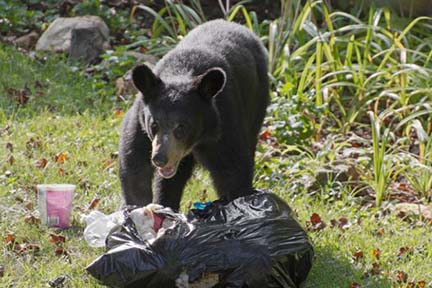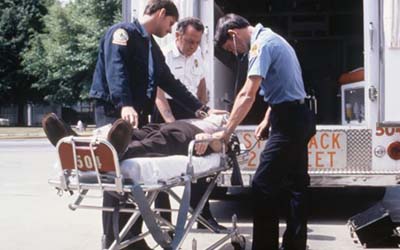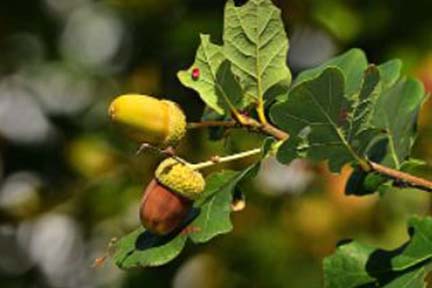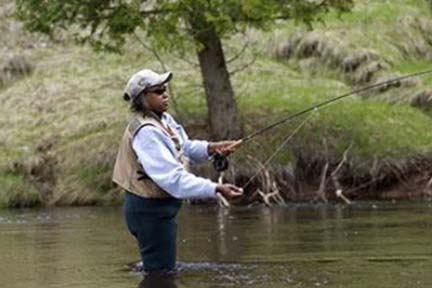| Here are a few of this week’s stories from the Michigan Department of Natural Resources:
See other news releases, Showcasing the DNR stories, photos and other resources at Michigan.gov/DNRPressRoom.
PHOTO FOLDER: Larger, higher-res versions of some of the images used in this email, and others, are available in this folder.

As spring appears, so do black bears. After a long winter of little to no eating, bears are leaving their dens on a quest for food and water to replenish their bodies. As bears get busier, taking bird feeders down, keeping garbage cans inside and removing outdoor pet foods now can prevent conflicts with bears later.
While natural food sources like water and green vegetation are available, eating from bird feeders, garbage cans, beehives and pet foods is like winning the calorie jackpot for a hungry bear. Though it’s good for bears to pack on the calories right now, it’s bad to allow them to eat from food sources near homes and can often lead to severe problems for both you and the bear.
Bears that feed from these types of food sources can become repeat visitors and over time may lose their fear of humans, cause damage to property or create dangerous situations for humans, livestock and pets – outcomes that rarely end well for the bear.
Spring is a critical time to think about how to coexist with wildlife and set up your home to have a conflict-free year. These simple actions can save you time, money and stress, and keep wildlife safely foraging at a distance.
- Remove bird feeders or replace with bird baths, nest boxes or native flowers.
- Bring in outdoor pet foods and keep grills and patio furniture clean.
- Secure garbage cans indoors overnight; take them to the curb the morning of pickup.
- Protect beehives and small apiaries with electric fencing.
Bears are an essential species in our ecosystems because of their critical roles as seed dispersers and insect and small mammal predators. As spring arrives and we spend more time outside, keep in mind that human behavior affects bear behavior. Don’t wait until you see a bear to act. Remove food sources and keep Michigan’s black bears at a distance.
To learn more about being Bear SMART this spring, visit Michigan.gov/Wildlife or contact the DNR Wildlife Division at 517-284-9453.
|
 Michigan’s state forest roads are the gateway to the rugged side of the outdoors. Pack your helmet, start up your off-road vehicle and download a map, then turn your steering wheel from pavement to gravel to find your next favorite place to hunt, hike or explore. Michigan’s state forest roads are the gateway to the rugged side of the outdoors. Pack your helmet, start up your off-road vehicle and download a map, then turn your steering wheel from pavement to gravel to find your next favorite place to hunt, hike or explore.
Every year, the DNR updates state forest road maps on April 1 to keep them current. Maps are available in an interactive web format and as printable PDFs at Michigan.gov/ForestRoads.
After the annual road inventory and review, 11,765 miles of forest roads in the following areas will be open to ORVs:
- Upper Peninsula: more than 5,686 miles – about 98% of the total mileage.
- Northern Lower Peninsula: about 6,068 miles – about 84% of the total mileage.
- Southern Lower Peninsula: just over 10 miles – about 3% of the total mileage.
Forest road maps are updated to reflect changing road conditions and to incorporate data cleanup and input received from residents. Maps show which state forest roads are open or closed to off-road and conventional vehicle use. It’s important to stay on these roads to prevent erosion and damage to wildlife habitat.
With this year’s update, a section of 189.7 miles of roads on property leased by the Camp Grayling National Guard facility has moved from closed year-round status to seasonally closed. This change opens recreational access except during seasonal military training operations. The roads are located northeast of Grayling, south of County Road 612. When the area is used for training activities, roads will be gated off for public safety. Notice will be posted on the Camp Grayling Facebook page and shared on local radio stations. A similar proposal was approved in 2022, opening seasonal access to 94.8 miles of forest roads north of County Road 612.
Review ORV rules, regulations, closures and more at Michigan.gov/ORVInfo. Find updated maps and other information at Michigan.gov/ForestRoads.
Questions about state forest roads? Email DNR-RoadInventoryProject@Michigan.gov. Send media inquiries to Jason Caron at 906-235-4361. |
 Looking ahead to summer bonfires, a warm woodstove next winter? A $20 fuelwood permit from the DNR lets you stock up on your woodshed needs. Looking ahead to summer bonfires, a warm woodstove next winter? A $20 fuelwood permit from the DNR lets you stock up on your woodshed needs.
Fuelwood permits are for personal use and allow a household to get up to five cords of firewood from designated areas of state forests in the Upper Peninsula and northern Lower Peninsula. A cord of wood is a stack measuring 4 feet by 4 feet by 8 feet. All wood must be collected from trees that are both dead and downed within 200 feet of a road.
Permits are valid for 90 days after issue date, but all expire Dec. 31 of the current year regardless of when they were purchased. To get your fuelwood permit, purchase online through DNR eLicense or at a DNR customer service center.
Fuelwood rules to know:
- Do not drive vehicles off the road to gather fuelwood. You may use a wheelbarrow or handcart to carry wood to your vehicle.
- Gather wood only from dead and downed trees. Do not cut live trees or standing dead trees.
- You must have the permit with you when collecting wood and fill out the collection log before transporting wood. Failure to do so could result in a citation.
- You may not sell or trade firewood collected under the fuelwood permit.
When moving firewood across distances, there’s always risk of spreading invasive pests and diseases. Collect wood nearest to where it will be used.
For more information on fuelwood permits and list of frequently asked questions, visit Michigan.gov/Fuelwood.
Questions about fuelwood? Contact forester Jake Reid at [email protected]. |

Each month, the DNR offers a variety of opportunities to help take care of Michigan’s natural and cultural resources. Here are a few ways to get involved in April.
State park volunteer workdays
Several state parks in southern Michigan will host stewardship workdays, where volunteers are needed to help remove invasive plants that threaten high-quality ecosystems.
Workdays will take place at:
- Bald Mountain Recreation Area (Oakland County), 9 to 11 a.m. Saturday, April 13, and 4 to 6 p.m. Monday, April 29.
- Muskegon State Park (Muskegon County), 10 a.m. to 12:30 p.m. Sunday, April 14.
- Waterloo Recreation Area (Washtenaw County), 10 a.m. to 1 p.m. Saturday, April 13, and Saturday, April 27.
- Highland Recreation Area (Oakland County), 10 a.m. to 1 p.m. Sunday, April 14, and Sunday April 21.
- Pinckney Recreation Area (Washtenaw County), 10 a.m. to 1 p.m. Saturday, April 20.
- Saugatuck Dunes State Park (Allegan County), 10 a.m. to 1 p.m. Saturday April 20.
- Yankee Springs Recreation Area (Barry County), 10 a.m. to 12:30 p.m. Sunday, April 21.
- Brighton Recreation Area (Livingston County), 10 a.m. to 1 p.m. Sunday, April 28.
Mears State Park in Oceana County will host its annual Spring Volunteer Day Saturday, April 27. A longstanding tradition at the park, the event gives volunteers a chance to pitch in by helping put out tables, benches and grills, cleaning campsites, painting park fixtures and other activities necessary to get the park ready for use. In return, those who want to camp and who complete a full day of volunteering earn a free camp night (must be used this weekend).
On the Ground habitat help
Join in fish and wildlife habitat improvement efforts with On the Ground, Michigan United Conservation Clubs’ volunteer program in partnership with the DNR. Projects coming up in April include:
- Annual Clinton River cleanup, 9 a.m. to 1 p.m. Saturday, April 13, at Yates Park in Rochester Hills (Oakland County). On the Ground will partner with Metro-West Steelheaders and the Clinton River Watershed Council to improve and enhance the quality of fish and wildlife habitat by removing trash in and around the Clinton River.
- Brush pile building in Kalkaska County, 10 a.m. to 3 p.m. Saturday, April 27. In partnership with Land Ethic, LLC, volunteers will help construct brush piles, which provide numerous benefits to a variety of wildlife, in the Traverse City Forest Management Unit in Kalkaska County.
|

Spring is here, and if you’re itching to get out and enjoy the outdoors – or learn more about nature and ways to explore it – check out our April event offerings. Here’s a sampling of what’s on tap; for a full list of DNR events, see Michigan.gov/DNRCalendar.
Learn new outdoor skills
Whether you want to pick up a new pursuit or some new tips and tricks from the pros, the DNR Outdoor Skills Academy offers expert instruction, gear and hands-on learning for a range of outdoor activities. April’s schedule includes:
Join us to watch the rare solar eclipse set to pass over North America April 8. These DNR locations will host viewing events:
No matter where you are when the eclipse occurs, remember to never look directly at the sun with your naked eye, even during a partial eclipse; always use certified eye protection. For more details and safety tips, check out NASA’s eclipse safety page.
Fun for everyone at the OAC
The Outdoor Adventure Center in Detroit offers a robust lineup of events for every age this month, including a new nature series for the youngest visitors and the popular Active Aging Adventures: Brunch and Learn series, which serves up a new speaker each month, plus some exciting family events featuring astrology and agriculture. Some April highlights:
|
 See more pictures by Michigan state parks photo ambassadors at Instagram.com/MiStateParks. For more on the program, call Stephanie Yancer at 989-274-6182. (This photo is by Danielle Grandholm, for the Michigan DNR, at Warren Woods State park in Berrien County). See more pictures by Michigan state parks photo ambassadors at Instagram.com/MiStateParks. For more on the program, call Stephanie Yancer at 989-274-6182. (This photo is by Danielle Grandholm, for the Michigan DNR, at Warren Woods State park in Berrien County).
|








